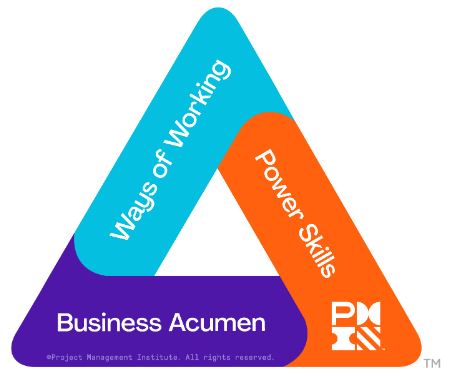
PMI Talent Triangle: Power Skills (Leadership)
Welcome to the PMO Strategies Podcast + Blog, where PMO leaders become IMPACT Drivers! We are on to the 3rd step in changing your mindset as a PMO leader. If you haven’t listened to episode 000, the Introductory episode or 001, The PMO Reset, or 002 talking all about instilling focus, or even 003 redefining what success looks like – then definitely go back and listen to or read those first. Starting at the beginning will be the stepping stones to how we got here, and help you understand why we must work on mindset first. Today in episode 004, we are diving into step 3, performing relentlessly.
This step in the process is crucial for building credibility with your PMO and leadership confidence in you as a PMO leader. IMPACT PMO Leaders understand that it’s not enough to stay busy, it’s not enough to show progress, we’ve got to Get. It. Done. consistently and reliably and have a relentless perseverance of IMPACT. Your goal is to drive a delivery focused mindset with your team, show that you understand that the work you are doing is for a greater purpose, ensure that you are keeping your commitments, minimize friction and barriers to IMPACT outcomes, and right-size your governance framework to drive the ideal state of IMPACT delivery. Let’s dig into the steps you can take to Perform Relentlessly.
1. Drive a Delivery-Focused Mindset
When we create process or tools or get busy managing projects, we must make sure that we keep our eye on the prize. Your job as an IMPACT PMO Leader is to ensure that everyone on the team sees the forest, not just the trees. We don’t allow our teams to get caught up in checking boxes or mindlessly following steps in a process. We don’t allow our teams to simply go through the motions of delivering capabilities or services for the organization. We ensure that everyone on the team is tirelessly driving toward creation of IMPACT. This means that we need to allow our teams some flexibility and space to find creative ways to solve problems, use only the tools in the toolbox that are enabling project delivery and throughput, and ensure that we think about delivering IMPACT through every service we create or interaction we have with stakeholders.
2. Talk IMPACT to Everyone
Performing relentlessly means that you are talking about the IMPACT you are making with everyone. When we are talking to people about the work we are doing, think about the language you use. Make sure you connect people to the outcomes you are creating instead of the steps you are taking to get there. Sometimes we will speak one language to our business stakeholders and then get right back to talking tools, process, and methodology when we go back to our team. Instead, make sure that are you are connecting the work that you are doing as a team directly to the IMPACT that work has on the overall organizational strategy. You will see performance increase if people are able to tie the work they are doing to the big picture of the organization. People want to see how they are part of the puzzle and how what they are doing matters. Show them just how much it matters.
3. Keep Commitments
If you want to build credibility, then you must do what you say you are going to do. Every time. That means being thoughtful and purposeful about the commitments you make and create a relentless pursuit of IMPACT on those most important priorities. People are counting on you. They are judging you. They are trying to figure out if they can rely on you to deliver. Show them that they can. You want to set expectations and then deliver on exactly what you said you were going to deliver. To do this, you must spend time defining and planning out the capabilities you will deliver with your PMO and ensuring that you are planning for the inevitable changes and roadblocks that will hamper your progress. Be good at planning before you do. Remember when we talked about saying “yes” to everyone and then not being able to deliver? Don’t forget how important it is to be thoughtful when setting expectations with your stakeholders and with yourself. It almost always takes longer than we think it will to get something done. Plan for the unplanned. I understand that it’s super easy for this one to go off the rails due to circumstances completely outside of your control. However, when things happen to derail us, often we could have had more influence if we had been proactively monitoring and managing the situation. I’m not saying to be an absolute control freak, just get smart about monitoring progress, checking in with people, and holding people accountable. It’s much easier for you to do what you say you are going to do when you can ensure the people that you are counting on to participate in that process are being held to the same standard.
4. Minimize Friction
Many times, PMO leaders start with the answer instead of the question. They come into an organization and immediately get down to the business of creating instead of doing, they start building instead of listening. Then, they are so excited for all these new templates, tools, and steps in a process and can’t figure out why everyone is running for the hills! Here’s a hint: Nobody wants that. What people want is for you to fix what’s broken and make things better. While you may realize that more structure and better discipline will help get them to the solution, you can’t start with that. No executive has ever said, “No, come back when you have 5 more templates for me to fill out!” Instead, they ask you to fix or improve something, so do that. Do that first, then you will build credibility and can slowly add just the right amount of process to solve just that immediate issue and get to a solution faster. Your goal is to minimize friction and barriers to progress. A key component of the IMPACT mindset is facilitating and enabling the delivery of projects, optimal performance, and increasing project throughput. Instead of finding ways to add more templates, or create new steps in a process, look for ways to streamline. What can you stop doing that isn’t being properly leveraged anyway? What steps are superfluous? What templates don’t really need to be filled out? Is there a better, faster, cheaper way to get to the same outcomes with fewer steps? Streamline what is used and how it’s used so that your team is driving faster throughput and faster project delivery across the board.
5. Right-Size Governance
We also need to right-size our governance if we’re going to drive relentless performance, meaning not every project or initiative requires the same level of oversight and governance to achieve IMPACT. Over-governing is a waste of time. If you allow people to have meetings just because they always do it or spend time creating, distributing, and reviewing reports or other data that isn’t driving change or decisions, then you are enabling waste. A lot of time that could otherwise be leveraged for higher-IMPACT opportunities is being squandered. Do what makes sense. Create a flexible approach to oversight and governance. If you have a three-month project and a three-year project, you want to have a different level of governance and right-size the meetings, oversight, and reporting and communications to that size, scope, and importance of the project. IMPACT PMO Leaders understand that to drive relentless performance, they must ensure that only what MUST get done, gets done. Anything that is extra is removed. If meetings don’t need to happen, they are canceled. If steps don’t need to take place, they don’t allow people to go through the motions. Instead, they explain the reason for the variance from the standard and keep everyone moving.
T hanks for taking the time to check out the podcast!
hanks for taking the time to check out the podcast!
I welcome your feedback and insights!
I’d love to know what you think and if you love it, please leave a rating and review in your favorite podcast player. Please leave a comment below to share your thoughts. See you online!
Warmly,
Laura Barnard







